Acid Tank Level Sensor -Submersible the Best Choice

The level of acid in tanks or other containers is measured using acid tank level sensors. They are specifically made to endure the corrosive and abrasive conditions of measuring acidic liquids. Although there are many various kinds of acid tank level sensors, submersible sensors are generally regarded as the finest option.
Sensors that can be submerged in acid are known as submersible acid tank level sensors. To withstand the corrosive qualities of the acid, they are often composed of sturdy materials like stainless steel or other corrosion-resistant materials. Numerous acidic liquids, such as sulfuric acid, hydrochloric acid, and nitric acid, can be measured with these devices.
There are two ways that submersible acid tank level sensors can function:
Contacting: These sensors make contact with the acid and measure the acid concentration using the buoyancy force of a float. The float floats up and down in response to changes in the acid level, changing the resistance, capacitance, or other physical characteristics of the sensor. The level of the acid is then calculated using this change.
Non-Contacting: These sensors measure the acid level using ultrasound, radar, or other non-contact techniques. They produce sound or microwave signals, which pass through the acid and are reflected off its surface. The distance to the acid surface and subsequently the level is determined by measuring the time it takes for the signal to travel and return.
Easy to install and maintain, submersible acid tank level sensors can be linked to a control system utilizing a number of different communication protocols, including 4-20 mA, HART, Modbus, Profibus, etc. They also have cutting-edge technologies like echo-to-echo processing and temperature adjustment, which allow precise measurement even in difficult settings.
Although submersible acid tank level sensors are widely regarded as the finest option, this choice will ultimately depend on the particulars of the acid and the application. Always seek the advice of a professional to choose the optimal level sensor for your individual requirements. Additionally, it’s crucial to take all required safety procedures to safeguard both persons and equipment when working with acids.
Learn more about level sensors
Please contact us to discuss your application


